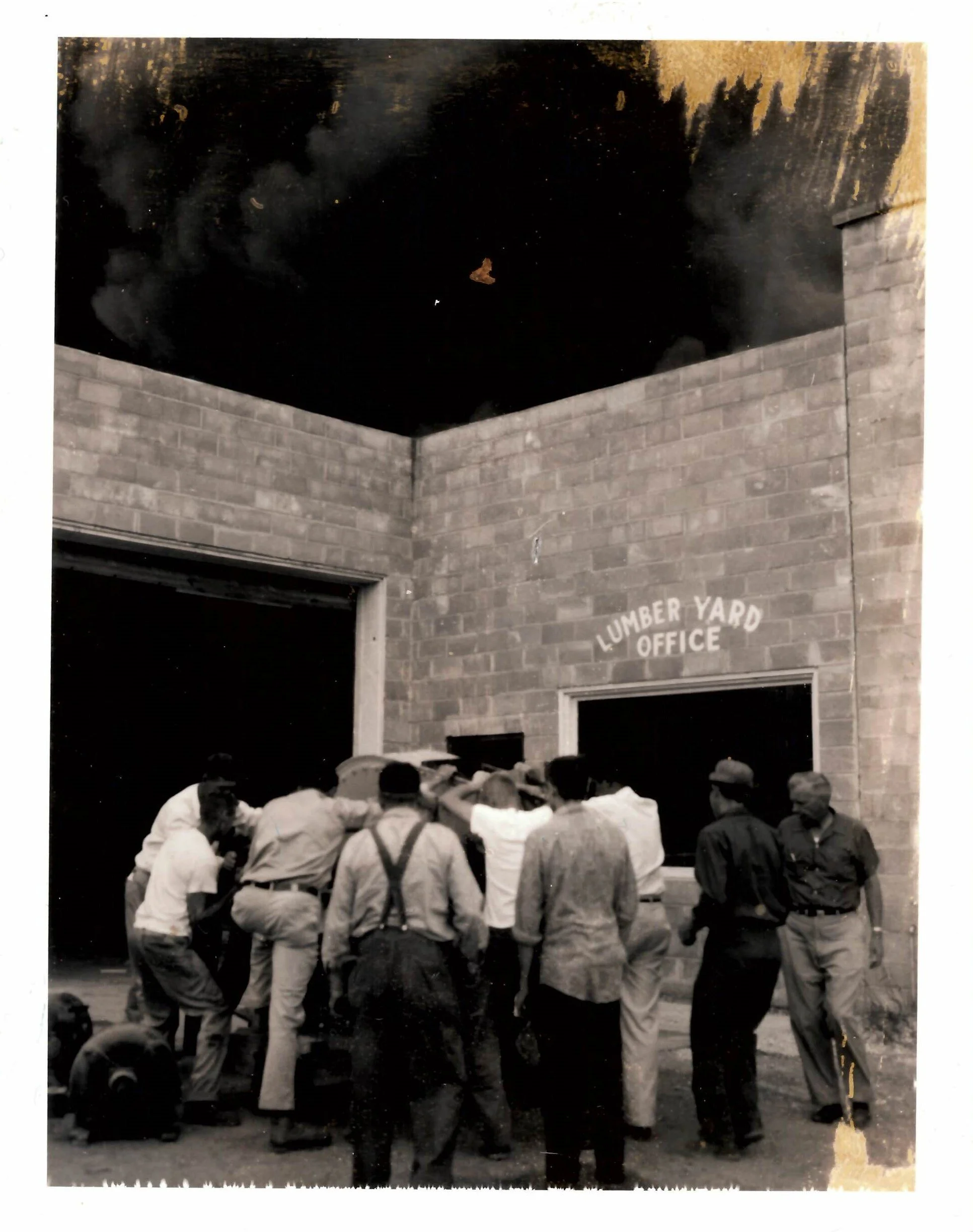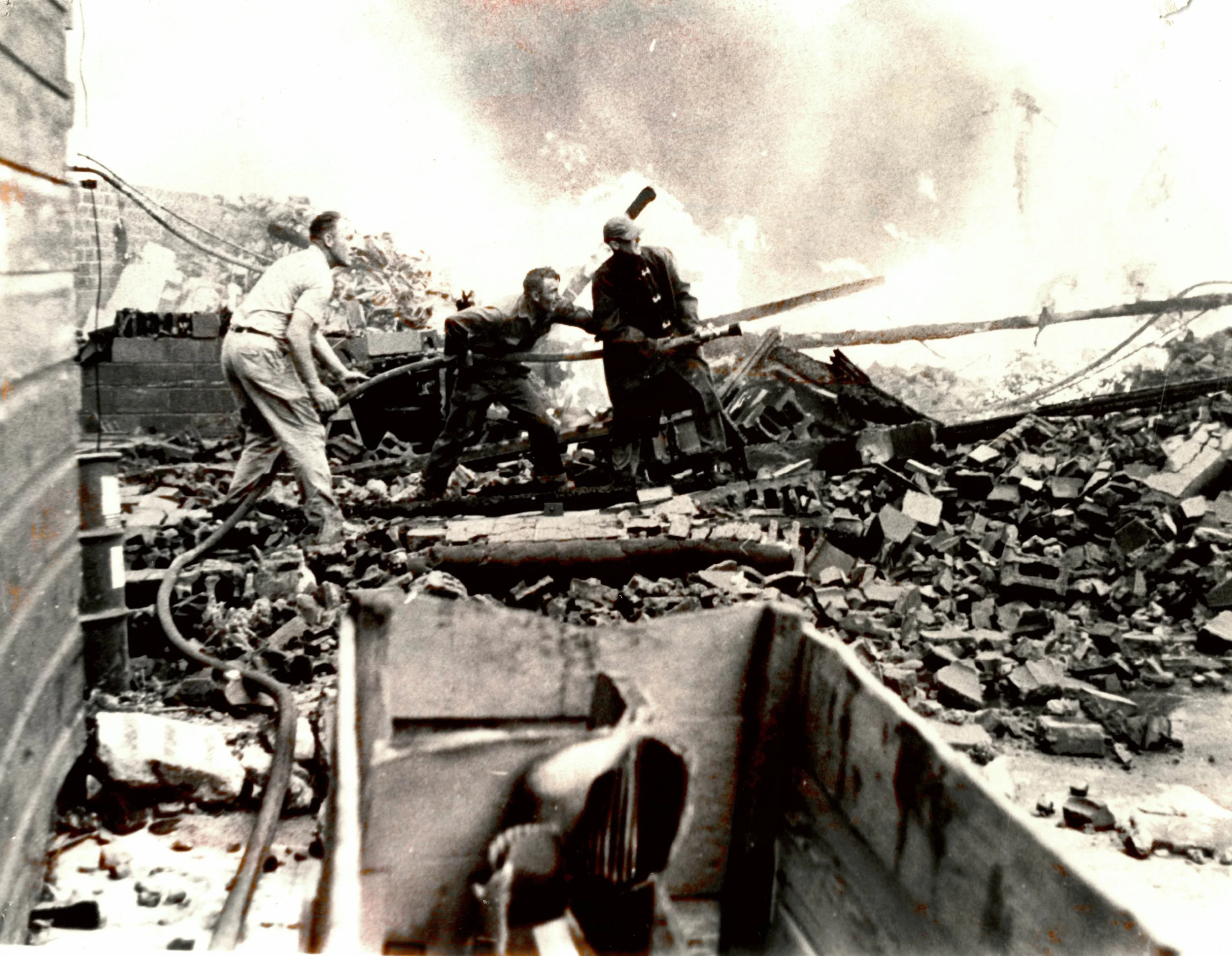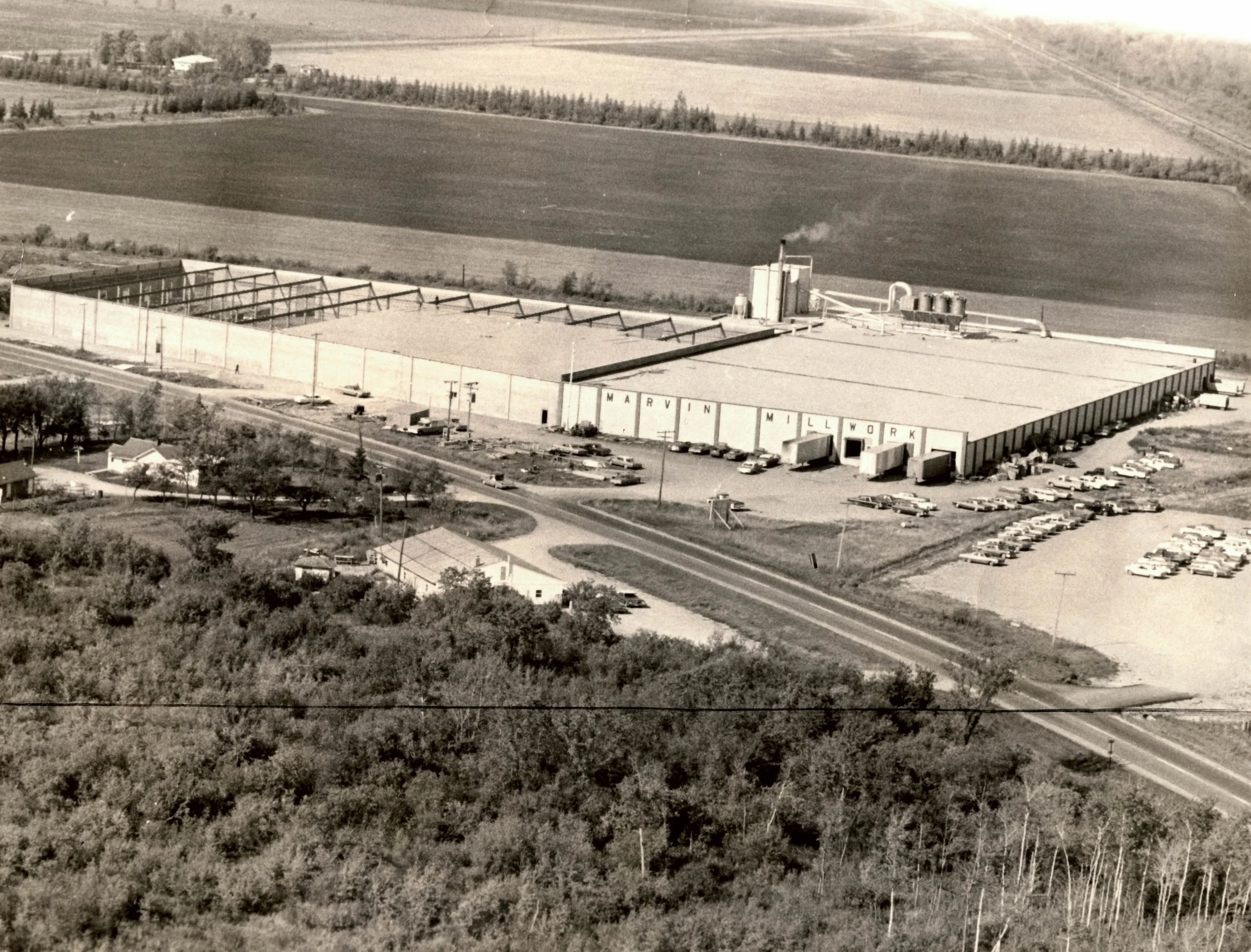Marvin Millwork Fire, 1961
$31,262.
That's how much money was to be divided amongst the 168 employees of Marvin Lumber Co. at the end of 1960. The amount was equal to 30 percent of the company's profits for that year, and it was distributed to employees in $2 bills, in order to keep the bill in local circulation, emphasizing the spread of money to the community. The largest bonuses that year were in the amount of $647, though the average amount received by an employee was closer to $180.
1960 was the fourth year of Marvin's annual profit sharing event, and the banquet was held at the Zion Lutheran Church in downtown Warroad. Around these parts, we refer to this event as simply "Bonus," because everyone knows what that means. It's a tradition that has lived on in Warroad and to national and international partners, through recessions, collapses, and failing markets.
At the banquet, George Marvin spoke about the workforce in Warroad and its achievements for the year. CPA Warren Johnson discussed the way bonuses were calculated and distributed. Charles Reinhart received a check for $100 for applying a tourniquet to another employee, Ed Schille, whose arm was stuck in a machine and torn up. Doctors told the company that without Reinhart's swift action, Mr. Schille might have died. Bill Marvin followed up the presentations and awards by asking the employees to remain good citizens in the local community and to be active participants in it. "Growth requires deep roots and a good foundation." (Warroad Pioneer 12/22/1960)
Marvin Millwork grain elevator on East Lake Street
Mrs. Evangeline Pick stepped out into her yard on the evening of June 27, 1961. Evangeline was an honest, hardworking woman who lived on the riverbank on the south side of town, facing west, towards downtown Warroad. It was like any other evening, with a cool breeze lifting off the river as the day's humidity began to drop. Perhaps she was going to garden, or perhaps she meant to take a walk. Why not, she must have thought. It was just an ordinary evening, or at least, it might have been, had she not seen smoke rising from the building across the river.
Rushing inside, Evangeline called into the local operator and alerted them to a possible fire downtown. At the same time, employees in the Marvin Millwork lumber yard were also dialing in to tell of a fire.
There were 78 men on site on the evening of June 27. The clock ticked just past 7 o'clock in the evening. One of the employees, Morton Jasmer, heard a nearby fire whistle. He initially shrugged it off; if it was serious, he'd have been informed.
A few moments later, Dick Dorwart called out to the group. There was a fire in the lumber yard.
Several workers leapt to their feet and began warning others in the vicinity. A few men attempted to close off the north end of the plant to cut the air supply, but the heavy door stuck and was soon too hot to touch.
As everyone knows, lumber burns fast. And it spreads.
Gary Zaiser was working on the south side of the plant near where the fire started. He was working on the conveyor belt when it suddenly stopped. His line partner, Richard Ganyo, said he thought he saw some sparks near the switch box, but couldn't be sure. They believed a fuse might have blown, and that's what stopped the conveyor belt. The two men collected themselves and went over to see what the problem was.
It was then they were confronted with flames and sparks surrounding one of the pipes used to vacuum wood shavings away.
Employees carrying lumber and supplies from the building
The plant covered nearly an entire city block, and the fire spread quickly throughout it. The Warroad Volunteer Fire Department arrived on scene swiftly to a blazing fire, and their trucks quickly proved inadequate to handle it. Fire trucks soon began arriving from Roseau, Baudette, and Williams. Hundreds of volunteers arrived to help battle the fire that was surely going to overrun the entire plant.
Jack Marvin (far left) with other unidentified firemen
79-year-old George Marvin assisting employees in evacuating supplies from the building.
As the firefighters battled the heat and flames, one of the plant's glue barrels exploded, launching the barrel into the air and colliding with Firefight Carroll Lunos. Lunos was thrown backward and his mask was torn from his face. He was rushed to the Warroad Hospital, only a few blocks away. Another firefight, Leonard Bloom, struggled to fight the flames but was soon overcome by the smoke and taken away from the scene. Yet another fireman, George Moen from Baudette, was injured by the fire truck that was being used to pump river water onto the flames. Smoke inhalation was rife amongst the many employees and bystanders attempting to help.
Luckily, none of the injuries were fatal.
Across the street, the Cities Service station began smoking due to the immense heat, as did two houses near the station. Luckily, none of them caught fire. Eventually, the fire was contained enough that all that remained was smoking rubble. At around 9 o'clock that evening, the final wall caved in as the horrified community watched.
View of the smoke from the south side of town, across the bridge
George Marvin took the loss the hardest. After all, this company was one he'd been building for decades, and now it lay, smoldering. The estimated loss was around $1.5 million. Only six months earlier, bonuses had been presented to employees and the company's leadership applauded their hard work. What was there to show for it now?
At 79, George Marvin was not ready for this to be the end of Marvin's. Pulling together his family, they got to work at rebuilding. It took about a month before the a temporary workshop was opened for employees to continue on the manufacturing line, but a new building was quickly planned and underway.
The city of Warroad understood the roots the Marvin Company had in the community. At a special meeting with the city council, the Municipal Light and Power Commission agreed to provide water and sewage for the proposed site of the new Marvin Millwork Factory. The city council also promised to look into tax relief programs for the project, and agreed to a lower electric rates for the temporary buildings in the interim. Trustee Dick Roberts is quoted as saying: "I think we should show by our actions here tonight that we want them [Marvin Millwork] here." (Warroad Pioneer)
Within the next month, George Marvin, Morris Taylor, and Bob Wenzel were traveling to various regions of the country to look at machinery to bring to Warroad. As they agreed upon more tools, the temporary manufacturing work was expanded. In the meantime, a high percentage of workers filed for unemployment after the fire. An editorial in the Pioneer noted that the first few months after the fire were "going to be rough sledding for many individuals and for the collective economy of a community which has come to lean heavily on a big payroll at Marvin Millwork and a fair agricultural income. This next year will be neither. The farmers were pulling in their belts before the fire. Now 150 workers are also pulling in their belts along with every merchant in Warroad."
Despite the unease that settled over the community, many individuals and organizations stepped in to help. The Warroad Lions Club sponsored clean-up crews to help the Millwork staff load up debris and remove burned machinery from the scorched earth. Clean-up was estimated to have taken about a week to complete in August, at the same time William S. Marvin was guaranteeing that the rebuilding project was moving steadily ahead. Hogenson Construction Company of Minneapolis was contracted to begin construction for the new millwork plant on the north side of town off Highway 11, where the current manufacturing plant resides.
Trucks assisting in clean-up of rubble
Construction began in early September and was expected to be completed within just two to three months. In October, the Roseau Electric Cooperative loaned around $250,000 to the project. It was expected that this loan would not only support the rebuilding efforts, but it would also allow Marvin's to help return some 160 people to their jobs. A few days later, the walls of the new building were erected.
Finally, in January 1962, the new plant opened and full production was achieved at the new Marvin Millwork plant. A total of 169 employees were taken on by March 12, organized into three working shifts supervised by Plant Superintendent Bob Wenzel. Many of the new employees were part-time farmers or commercial fishermen, but the shifts also included three women and two pastors.
The new Marvin Millwork Factory, 1960s
The economic impact on Warroad was powerful, but a year and a half after the fire, Marvin Millwork was once again hosted its profit-sharing event, fulfilling their duty as a faithful employer to many in the Warroad community.
Marvin Windows Manufacturing Plant, early 2000s
The company has grown tremendously since the early 1960s. But, there's a few things we can learn from this harrowing event in downtown Warroad. The first is that, at its heart and from the beginning, Marvin's was a company that had deep roots int he community, and they have worked hard to maintain those roots for more than a century. Second, there are few tragedies that can befall a community that can break it when citizens come together to lend a hand. Warroad has often shown itself to be giving, kind, and courageous. Whether it be pandemics, recessions, or tragedy, there's no shortage of neighbors you can lean on.
We know many of you have your own stories about the Marvin Millwork Fire and working for the company. Be sure to share them in the comments!
~ Erin Thompson, Museum Manager

















